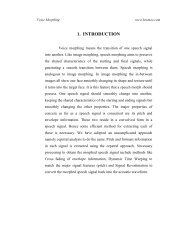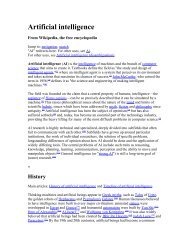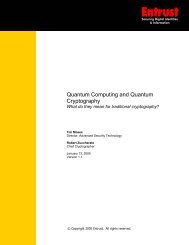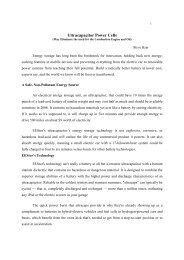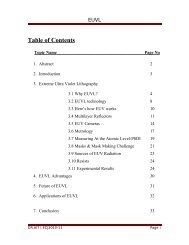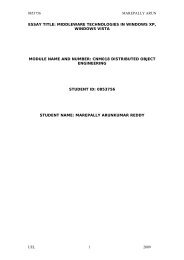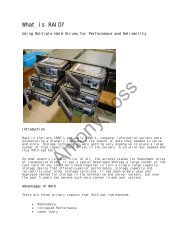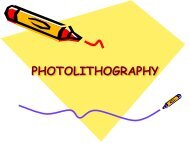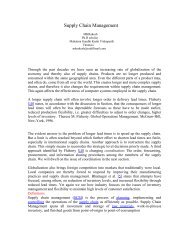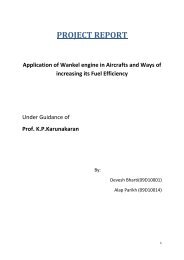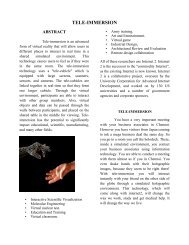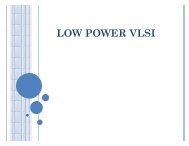WHAT IS ANIMATRONICS??? - 123SeminarsOnly
WHAT IS ANIMATRONICS??? - 123SeminarsOnly
WHAT IS ANIMATRONICS??? - 123SeminarsOnly
You also want an ePaper? Increase the reach of your titles
YUMPU automatically turns print PDFs into web optimized ePapers that Google loves.
<strong>WHAT</strong> <strong>IS</strong> <strong>ANIMATRONICS</strong>???<br />
Animatronics is a combination of animation and electronics. What<br />
exactly is an animatronic? Basically, an animatronic is a mechanized puppet. It<br />
may be preprogrammed or remotely controlled. The animatronic may only<br />
perform a limited range of movements or it may be incredibly versatile. Later<br />
animatronics was used together with digital effects. Through the precision,<br />
ingenuity and dedication of their creators, animatronic creatures often seem as<br />
real to us as their flesh-and-blood counterparts.<br />
An animatronic figure is often used in movies to create grand special<br />
effects. Examples of these figures include the scare created by the Great White<br />
coming out of the water in "Jaws" and the tender otherworldliness of "E.T." are<br />
cinematic effects that will not be easily forgotten. The advantages of animatronics<br />
has over digital effects in some movies is more realistic close-up shots. Another<br />
use of animatronics in the entertainment industry is in theme parks. Rides such<br />
as Its a Small World, Pirates of the Carribean, and Country Bear Jamboree at<br />
Disneyland all include animatronics to transport the visitor into a new, lifelike,<br />
fantasy world.<br />
Animatronics are a specific type of robot. They defer from common robots<br />
such as robots used in search and rescue operations, in space, and in deep<br />
water because animatronic figures are not designed to be intelligent. Instead,<br />
they have been created mainly to entertain. Unlike many modern robots who<br />
respond to external stimuli, animatronics imitate the movements of intelligent<br />
characters with pre-programmed motions, words, and songs.
EARLY DEVELOPMENT OF <strong>ANIMATRONICS</strong><br />
The first use of Audio-Animatronics was for Walt Disney's Enchanted<br />
Tiki Room in Disneyland, which opened in June, 1963. The Tiki birds were<br />
operated using digital controls; that is, something that is either on or off. Tones<br />
were recorded onto tape, which on playback would cause a metal reed to<br />
vibrate. The vibrating reed would close a circuit and thus operate a relay. The<br />
relay sent a pulse of energy (electricity) to the figure's mechanism which would<br />
cause a pneumatic valve to operate, which resulted in the action, like the<br />
opening of a bird's beak. Each action (e.g., opening of the mouth) had a<br />
neutral position, otherwise known as the "natural resting position" (e.g., in the<br />
case of the Tiki bird it would be for the mouth to be closed). When there was<br />
no pulse of energy forthcoming, the action would be in, or return to, the natural<br />
resting position.<br />
This digital/tone-reed system used pneumatic valves exclusively--that<br />
is, everything was operated by air pressure. Audio-Animatronics' movements<br />
that were operated with this system had two limitations. First, the movement<br />
had to be simple--on or off. (e.g., The open and shut beak of a Tiki bird or the<br />
blink of an eye, as compared to the many different positions of raising and<br />
lowering an arm.) Second, the movements couldn't require much force or<br />
power. (e.g., The energy needed to open a Tiki Bird's beak could easily be<br />
obtained by using air pressure, but in the case of lifting an arm, the pneumatic<br />
system didn't provide enough power to accomplish the lift.) Walt and WED<br />
knew that this this pneumatic system could not sufficiently handle the more<br />
complicated shows of the World's Fair. A new system was devised.<br />
In addition to the digital programming of the Tiki show, the Fair shows required<br />
analog programming. This new "analog system" involved the use of voltage
egulation. The tone would be on constantly throughout the show, and the<br />
voltage would be varied to create the movement of the figure. This "varied<br />
voltage" signal was sent to what was referred to as the "black box." The black<br />
boxes had the electronic equipment that would receive the signal and then<br />
activate the pneumatic and hydraulic valves that moved the performing figures.<br />
The use of hydraulics allowed for a substantial increase in power, which was<br />
needed for the more unwieldy and demanding movements. (Hydraulics were<br />
used exclusively with the analog system, and pneumatics were used only with<br />
the tone-reed/digital system.)<br />
There were two basic ways of programming a figure. The first used<br />
two different methods of controlling the voltage regulation. One was a joystick-<br />
like device called a transducer, and the other device was a potentiometer (an<br />
instrument for measuring an unknown voltage or potential difference by<br />
comparison to a standard voltage--like the volume control knob on a radio or<br />
television receiver). If this method was used, when a figure was ready to be<br />
programmed, each individual action--one at a time-- would be refined,<br />
rehearsed, and then recorded. For instance, the programmer, through the use<br />
of the potentiometer or transducer, would repeatedly rehearse the gesture of<br />
lifting the arm, until it was ready for a "take." This would not include finger<br />
movement or any other movements, it was simply the lifting of an arm. The<br />
take would then be recorded by laying down audible sound impulses (tones)<br />
onto a piece of 35 mm magnetic film stock. The action could then instantly be<br />
played back to see if it would work, or if it had to be redone. (The machines<br />
used for recording and playback were the 35 mm magnetic units used primarily<br />
in the dubbing process for motion pictures. Many additional units that were<br />
capable of just playback were also required for this process. Because of their<br />
limited function these playback units were called "dummies.")
Eventually, there would be a number of actions for each figure,<br />
resulting in an equal number of reels of 35 mm magnetic film (e.g., ten actions<br />
would equal ten reels). All individual actions were then rerecorded onto a<br />
single reel--up to ten actions, each activated by a different tone, could be<br />
combined onto a single reel. For each action/reel, one dummy was required to<br />
play it back. Thus for ten actions, ten playback machines and one recording<br />
machine were required to combine the moves onto a new reel of 35 mm<br />
magnetic film.<br />
"Sync marks" (synchronization points) were placed at the front end of each<br />
individual action reel and all of the dummies were interlocked. This way, during<br />
the rerecording, all of the actions would start at the proper time. As soon as it<br />
was finished, the new reel could be played back and the combined actions<br />
could be studied. Wathel, and often times Marc Davis (who did a lot of the<br />
programming and animation design for the Carousel show) would watch the<br />
figure go through the motions of the newly recorded multiple actions. If it was<br />
decided that the actions didn't work together, or something needed to be<br />
changed, the process was started over; either by rerecording the individual<br />
action, or by combining the multiple actions again. If the latter needed to be<br />
done, say the "arm lift action" came in too early, it would be accomplished by<br />
unlocking the dummy that had the "arm-lift reel" on it. The film would then be<br />
hand cranked, forward or back, a certain number of frames, which changed the<br />
start time of the arm lift in relation to the other actions. The dummies would be<br />
interlocked, and the actions, complete with new timing on the arm lift, would be<br />
recorded once again.<br />
With this dummy system, the dialogue and music could also be<br />
interlocked and synched-up with the actions. Then the audio could be listened
to as the figure went through the actions. This was extremely helpful in getting<br />
the gestures and actions to match the dialogue.<br />
The other method used for programming a figure was the control harness. It<br />
was hooked up so that it would control the voltage regulation relative to the<br />
movements of the harness. Wathel tells horror stories of sitting in the harness<br />
for hours upon end, trying to keep every movement in his body to a minimum,<br />
except for the several movements they wanted for the figure. This method had<br />
the advantage of being able to do several actions at once, but obviously due to<br />
the complexities, a great deal of rehearsal was required.<br />
There was also a harness for the mouth movements. Ken O'Brien,<br />
who was responsible for programming most of the mouth movements, used a<br />
transducer at first for the mouth programming. Later they designed a harness<br />
for his head that controlled the movement of the jaw," remembered Gordon<br />
Williams, recording engineer on the AA figures for the Fair. "It was easier for<br />
him to coordinate the movement, because he could watch the movement at<br />
the same time that he was doing it."
FORMATION OF <strong>ANIMATRONICS</strong><br />
Step 1: Design Process<br />
During the design process, the client and the company developing the<br />
animatronics decide what the character will be,its appearance total number of<br />
moves, quality of moves, and what each specific move will be. Budgets ,time<br />
lines and check points are established. Many years have been spent to<br />
ensure that this critical step is as simple as possible. Once this critically<br />
important stage is solidified and a time line is agreed upon, the project moves<br />
to the sculpting department.<br />
Step 2: Sculpting<br />
The sculpting department is responsible for converting two-<br />
dimensional ideas into three-dimensional forms. This team can work from<br />
photos, artwork, videos, models, statuettes and similar likenesses. Typically,<br />
the client is asked to approve the sculpting before it goes to the molding<br />
department.<br />
Step 3: Mold making<br />
The molding department takes the form created by the sculptor and<br />
creates the molds that will ultimately produce the character skins. Molds can<br />
be soft or hard, single or multiple pieces, and reusable or non-reusable. To get
the sculptor’s exact interpretation, mold making is both an art form and an<br />
elaborate technical process. The process can be very time-consuming and<br />
complicated. It can be so unnerving that some animation mold makers even<br />
refer to it as “black magic.”<br />
After the mold is finished and cured, it is ready for skin making. Fiber<br />
glass shells are simultaneously being laid up to form the body and limb<br />
shapes. Some of these shapes are reusable stock pieces, but the majority of<br />
shells are custom made for each character.<br />
Step 4: Armature Fabrication<br />
Meanwhile, various body armatures are being created and are<br />
assembled in the welding metal-fabricating areas. Each of the robot’s<br />
movements axis points must have an industrial-rated bearing to provide action<br />
and long life. Each individual part requires a custom design and fabrication.<br />
These artisans are combining both art and technology to achieve realistic,<br />
lifelike moves.<br />
As the armature takes shape, the actuators, valves, flow controls and<br />
hoses are installed by the animation department. The technicians select those<br />
components carefully in order to ensure the durability and long life. As it’s<br />
assembled, each robotic move is individually tested and adjusted to get that<br />
perfect movement.<br />
Step 5: Costuming<br />
The costume, if there is one, is usually tailored to the character and its
movements. Animation tailoring can be a very difficult tedious process<br />
considering the variables. The outfit has to allow for easy acces to the<br />
character’s operating mechanisms. It must also “look” normal after movement<br />
has taken place. The costume must be designed to provide hundreds of<br />
thousands of operations without wearing out and without causing the skin<br />
areas(i.e. around the necks or wrists) to breakdown as well.<br />
Step 6: Programming<br />
Finally, if it is an animated character the electronic wizard move in to<br />
connect the control system into valve assembly in the preparation for<br />
programming. Programming is the final step, and for some animations it is the<br />
most rewarding. Programming can be done either at the manufacturing facility<br />
or at the final installation site. In programming, all the individual moves are<br />
coordinated into complex animated actions and nuances that bring the<br />
character to “life.”
4.AN EXAMPLE: MAKING OF ANIMATRONIC<br />
SPINOSAURUS USED IN JURASSIC PARK<br />
Long before digital effects appeared, animatronics were making cinematic<br />
history. But it was in Jurassic park that the best possible combination of animatronics<br />
and digital effects were used together. Spinosaurus was a new dinosaur animatronic<br />
created for "Jurassic Park III" by Stan Winston Studio (SWS). Below lies the<br />
discussion of the amazing process that creates and controls a huge animatronic like<br />
this dinosaur!<br />
1Jurassic Machines<br />
2Dinosaur Evolution<br />
3In the Beginning<br />
4Creature Creation<br />
5Putting it together<br />
6Making it Move<br />
7Monster Mash<br />
4.1. Jurassic Machines<br />
The "Jurassic Park" series is known for the realism of its creatures,<br />
both the animatronic and digital versions. When the original "Jurassic Park"<br />
came out in 1993, it set a new standard for the realistic portrayal of dinosaurs,<br />
creatures that have never been seen alive by man. "Jurassic Park II: The Lost<br />
World" continued to improve the vision, and "Jurassic Park III," the latest movie<br />
in the series, raised the bar once again.
Below lies the amazing Spinosaurus statistics:<br />
1It is 43.5 feet (13.3 m) long -- almost as long as a bus -- and weighs 24,000<br />
pounds (10,886.2 kg/12 tons).<br />
2It is powered entirely by hydraulics, even down to the blinking of the eyes.<br />
This is because the creature was made to work above and below water.<br />
3There are 42 hydraulic cylinders and approximately 2,200 feet (671 m) of<br />
hydraulic hoses.<br />
4The creature moves on a track that is 140 feet (43 m) long and made from<br />
a pair of 12-inch (30.48 cm) steel I-beams.<br />
5All pivots use roller-bearing construction.<br />
6All large steel pieces were cut using waterjets.<br />
7The creature is completely remote-controlled.<br />
4.2. Dinosaur Evolution<br />
steps:<br />
Building the Spinosaurus, or any other animatronic, requires several major<br />
1Put it on paper.<br />
2Build a maquette (miniature model).<br />
3Build a full-size sculpture.<br />
4Create a mold (from the sculpture) and cast the body.<br />
5Build the animatronic components.<br />
6Put it all together.<br />
7Test it and work out any bugs.<br />
4.3. In the Beginning<br />
The first two steps in creating an animatronic are the sketches and the
miniature model.<br />
Put it on Paper<br />
The first thing that happens with any animatronic is that an artist<br />
creates preliminary sketches of the creature. The Spinosaurus sketches were<br />
developed by working closely with expert paleontologist Jack Horner and the<br />
crew working on "Jurassic Park III." The sketches are analyzed and changes<br />
are suggested. Eventually, the artist creates a detailed illustration of the<br />
creature.<br />
Build a Maquette<br />
From the final paper design, a miniature scale model called a<br />
maquette is created. Fashioned out of clay, the first maquette SWS made of<br />
Spinosaurus was one-sixteenth scale. This initial maquette is used to verify<br />
that the paper design is accurate. If there are any problems, they are corrected<br />
and a new paper design is made.<br />
Next, a one-fifth-scale maquette is made. This sounds small, until you<br />
realize the sheer size of the Spinosaurus. The one-fifth-scale model was about<br />
8 feet (2.4 m) long! The larger maquette allows the designers to add more<br />
surface detail. This maquette is then used to produce the full-size sculpture.<br />
Build a Full-size Sculpture<br />
For the animatronic dinosaurs in the original "Jurassic Park," SWS had<br />
to build the full-size sculpture by hand, a time-consuming and laborious<br />
process. Advances in computer-aided manufacturing (CAM) allow them to<br />
automate a significant part of this step.<br />
The maquette is taken to Cyber F/X, where it is scanned by a 3-D
digitizer. This is nothing like a normal computer scanner. There are a variety of<br />
methods used in 3-D digitizers, but the one that was used for Spinosaurus is<br />
called laser scanning.<br />
Laser scanning takes precise measurements of the maquette by<br />
bouncing beams of laser light off its surface. As the laser scanner moves<br />
around the maquette, it sends over 15,000 beams per second. The reflected<br />
light from the beams is picked up by high-resolution cameras positioned on<br />
either side of the laser. These cameras create an image of the slice (cross<br />
section) of the object that the laser is scanning. A custom computer system<br />
collects the cross sections and combines them to create a perfect, seamless<br />
computer model of the maquette.<br />
Cyber F/X then used the computer model to mill the life-size model of<br />
the Spinosaurus from polyurethane foam. This very rigid foam is cut to the<br />
correct shape through a proprietary process called CNC-Sculpting. This<br />
process, developed by Cyber F/X, takes the data from the full-scale computer<br />
model and divides the model into manageable chunks. The data for each<br />
chunk is then sent to the foam-sculpting machine, where a life-size section of<br />
the dinosaur is created by whittling away pieces of foam from a large, solid<br />
block using tiny spinning blades. Once all the sections are done, the SWS<br />
team assembles the pieces like a giant 3-D jigsaw puzzle. This creates a very<br />
basic full-sized model. A lot of work still needs to be done and it is handled by<br />
a team of sculptors at Stan Winston Studio. They hand-carve the foam to add<br />
all the incredible details that make it seem real.<br />
Molding and Casting<br />
A set of molds are made of the full-sized sculpture. The molds are<br />
made from an epoxy that is very durable and has strong bonding
characteristics.<br />
Once the components of the animatronic are ready, much of the frame<br />
work is test fitted inside the molds before the foam rubber skin is cast. In<br />
conjunction with this step is the fabrication of the foam-running core, which is<br />
created by lining the inside of the mold with precise layers of clay to represent<br />
the skin thickness. When the clay lay-up is completed, the surface of the clay<br />
is fiberglassed to create the foam-running core. After the clay is cleaned out,<br />
the foam-running core is bolted into the mold and creates a negative space<br />
between the foam-running core and detailed surface of the mold. When filled<br />
with foam rubber, this negative space becomes the skin.<br />
The purpose of this process is twofold:<br />
1It makes the skin movement seem more natural<br />
2It controls the skin’s thickness and weight<br />
4.4. Creature Creation<br />
Build the animatronic components<br />
Building the various components used in the animatronic usually takes<br />
the longest time. Most of the creatures that are developed at Stan Winston<br />
Studio require parts that you're not going to find at your local hardware store.<br />
This means that SWS has to build almost everything themselves. They do take<br />
advantage of any existing products when possible, usually by repurposing<br />
parts of a common device to fill some of their uncommon needs.
Basically, there are four main categories that the work splits into, with<br />
development happening simultaneously across the categories:<br />
Mechanical –<br />
SWS engineers design and build the mechanical systems, which<br />
includes everything from basic gears to sophisticated hydraulics. An interesting<br />
fact about the Spinosaurus animatronic is that nearly all of the mechanical<br />
systems used in it are hydraulic.<br />
Electronic –<br />
Another group develops the electronic control systems needed to<br />
operate the animatronic. Typically starting from scratch and creating their own<br />
custom circuit boards, these engineers are essentially building giant remote-<br />
controlled toys. Almost all of the movement of the Spinosaurus will be<br />
manipulated by specialized remote-control systems known as telemetry<br />
devices.<br />
Structural –<br />
All of the electronic and mechanical components need something to<br />
attach to and control, and the skin must have a frame to maintain its shape.<br />
This is done by building a plastic and steel frame. To increase the realism, and<br />
because it is the natural way to design it, the frame of the Spinosaurus, as well<br />
as most other creatures made by SWS, resembles the actual skeleton of the<br />
beast. This skeletal frame is largely comprised of graphite, a synthetic material<br />
known for its strength and lightness.<br />
Surface –<br />
The "skin" of the Spinosaurus is made from foam rubber, which is a
very light, spongy rubber that is made by mixing air with liquid latex rubber and<br />
then curing (hardening) it. While there are other compounds, such as silicone<br />
and urethane, that are stronger and last longer, foam rubber is used because it<br />
is much easier to work with. The solution is poured into each mold and allowed<br />
to cure. As mentioned earlier, parts of the frame are embedded with the foam<br />
rubber at certain points. To further strengthen the skin, a piece of fabric is cut<br />
to size and embedded in the foam rubber after it is poured into the mold. Once<br />
cured, each piece of skin is pulled from its mold.<br />
4.5. Putting it Together<br />
When all the components are done, it's time to build the Spinosaurus.<br />
The frame is put together and then the mechanical systems are put in place.<br />
As each component is added, it is checked to ensure that it moves properly<br />
and doesn't interfere with other components. Most of the electronic<br />
components are then connected to the mechanical systems they will control.<br />
The controls have been tested with the mechanical systems prior to final<br />
assembly, but the systems are checked again.<br />
Parts of the skin that have embedded pieces of the frame in them are<br />
put in place when the frame is assembled. The other skin pieces are fastened<br />
in place on the frame once the mechanical and electronic components are<br />
installed. Assembling the skin is a very laborious process. As each piece is<br />
added, the team has to check to make sure there are no problems - such as<br />
unwanted folds buckling, stretching, too tight.<br />
Whenever one of these problems occurs, the skin must be adapted or<br />
attached differently. Also, there are places where you do want the skin to fold<br />
or hang loose or travel in a certain way, and it must be adjusted to achieve that
effect. One of the tricks that SWS uses to make the Spinosaurus and other<br />
dinosaurs seem more realistic is to attach bungee cords between areas of skin<br />
and the frame. During movement, these bungee cords simulate tendons under<br />
the skin, bunching and stretching.<br />
Painting the skin<br />
The skin is mostly "painted" before it is attached to the frame. Stan<br />
Winston Studio does not use actual paint, though. Instead, a specially<br />
formulated mixture that is akin to rubber cement is used. Tints are added to the<br />
mixture to get the correct color. Rosengrant says that they use this mixture in<br />
place of traditional paint because it bonds more strongly with the foam rubber<br />
and stretches with it as the animatronic moves. Once the animatronic is<br />
complete, the team has to test it and work out any problems.<br />
Making it Move<br />
The people that control an animatronic are called puppeteers, because<br />
that is all that an animatronic is -- a sophisticated puppet. These puppeteers<br />
are skilled actors in their own right and will spend some time with the<br />
animatronic learning its range of movements. Rosengrant calls this "finding the<br />
performance." The puppeteers are determining what movements make the<br />
animatronic look angry, surprised, hungry or any other emotions or moods that<br />
are called for in the script.<br />
Eight puppeteers operate the Spinosaurus:<br />
1Basic head/body - swivels head, opens and closes jaws, moves neck back<br />
and forth, makes body sway from side to side<br />
2Tongue slide levers - moves tongue up and down, side to side and in or out
3Eye joystick control - eyes move, eyelids blink and eye ridge moves<br />
4Front arms - full range of motion; hands open and close<br />
5Cart/body - moves creature back and forth on track<br />
6Breathing potentiometer - inflated bladder inside chest cavity simulates<br />
breathing<br />
7Tail - full range of motion<br />
8Body raise slider - raises and lowers body<br />
4.6. Monster Mash<br />
Because the Spinosaurus animatronic is controlled by radio-frequency<br />
(RF) devices, certain precautions must be taken when it is in use. Any other<br />
device, such as a cell phone, that operates using RF technology must be<br />
turned off in the vicinity of the animatronic. Otherwise, improper signals can<br />
interfere with the control signals. This could have disastrous effects when<br />
dealing with a 12-ton monster. Clean power is important for the same reason.<br />
The Spinosaurus has a dedicated uninterruptible power supply (UPS) so that a<br />
power surge or brownout would not cause it to go out of control.
5. BUILDING YOUR OWN <strong>ANIMATRONICS</strong><br />
<strong>WHAT</strong> <strong>IS</strong> AN <strong>ANIMATRONICS</strong> KIT?<br />
Everything you need (except batteries and imagination) is included in<br />
our easy-to-use kit. Connect the cable to your PC's serial port, install the<br />
software and you're ready to start. No soldering or programming skills<br />
required. If you can use Windows you can use this Animatronics Kit . The<br />
software allows you to record the movements of hobby servos (up to two billion<br />
moves) and play them back exactly as recorded. Make your creation come to<br />
life!<br />
Kit Includes:<br />
Servo controller circuit board<br />
Two Hitech HS-300 hobby servos<br />
Mini SSC Panel v1.2 software<br />
Battery Pack<br />
Two servo horn assembly packs<br />
System Requirements:<br />
486 or higher processor (Pentium<br />
recommended)<br />
8 megabytes of RAM (32<br />
recommended)<br />
3.5" 1.44MB floppy<br />
Windows 3.x, 95, 98 or NT<br />
Available serial port
Illustrated Instruction manual<br />
Mini SSC Panel v1.2 software<br />
20 Megabytes of hard drive space<br />
The Mini SSC Panel v1.2 software is a Windows based computer<br />
program that allows you to explore the exciting world of animatronics (a<br />
combination of animation and electronics) with ease. With this program, you<br />
can control the movements of standard hobby servos attached to just about<br />
any creation you can imagine. Create robot figures that move on your<br />
command or puppets that seem to come alive. The possibilities are endless.<br />
What is the Mini SSC Panel?<br />
The Mini SSC Panel is a graphical user interface allowing you to easily<br />
control standard hobby servos attached to a serial servo controller (SSC)<br />
circuit board. This interface provides setup, movement control and movement<br />
recording/playback features.<br />
What's new in the Freelance Edition?<br />
New features include:<br />
1"Sleep" Mode<br />
2Playback Looping<br />
3Editable recordings<br />
4"Script Manager"<br />
5Servo Labeling<br />
6Recording and Playback step readout<br />
7Smoother Playback
8Enhanced user guide and help system<br />
Using the Software:<br />
The Control Panel<br />
The Control Panel is the first screen to contain servo motion controls.<br />
You use common Windows scroll bars to control the servos attached to your<br />
SSC(s). The Control Panel is an excellent tool to calibrate your animatronic<br />
creation.<br />
Use the Control Panel to:<br />
1Test SSC/servo connections and functionality<br />
2Test the minimum bounds of your servos<br />
3Test the maximum bounds of your servos<br />
4Determine the "Home" position of your servos<br />
5Experiment with different speeds<br />
6Devise recording strategies and positioning techniques<br />
The Recorder<br />
The interface to record animatronic projects is a flexible and easy-to-<br />
use. With the Mini SSC Panel v1.2 Freelance Edition you can combine small<br />
sub-recordings into larger more robust animatronic productions using our<br />
"Script Manager." By creating smaller recordings and compiling them into<br />
larger "Scripts" you can focus on each detail of your animation. For instance,<br />
once you have the gripper on your robotic arm working exactly the way you<br />
want, you can use that piece over and over again in your final script to keep<br />
your movements consistent.
Script Manager<br />
One of the most exciting features of the Mini SSC Panel v1.2<br />
Freelance Edition is the Script Manager. The Script Manager allows you to<br />
group smaller sub-recordings into larger, more robust animation productions.
6. CONCLUSION<br />
Creating a good animatronic figure that is able to perform constantly<br />
without fail requires many special skills and lots of technical know how. Before<br />
assuming the task of creating an animatronic figure, you should have a strong<br />
hold on how these things are constructed and be willing to spend a pretty penny<br />
on equipment and materials.<br />
Animtronics has now developed as a career which may require combined<br />
talent in Mechanical Engineering , Sculpting / Casting , Control Technologies ,<br />
Electrical / Electronic , Airbrushing , Radio-Control etc.But the realistic<br />
creatures that it can create are amazing and is rewarding to its creator.
1.www.howstuffworks.com<br />
2.www.animatronics.org<br />
3.http://www.mister-computer.com<br />
4.http://www.lifeformations.com<br />
7.REFERENCES
ACKNOWLEDGEMENT<br />
I express my sincere thanks to Prof. M.N Agnisarman Namboothiri<br />
(Head of the Department, Computer Science and Engineering, MESCE), Mr.<br />
Zainul Abid (Staff incharge) for their kind<br />
co-operation for presenting the seminar.<br />
I would like to thank Mr Steve Waddell of isupportlearning for his help<br />
in collecting material concerning my topic through out the seminar. His help<br />
has been invaluable.<br />
I also extend my sincere thanks to all other members of the faculty of<br />
Computer Science and Engineering Department and my friends for their co-<br />
operation and encouragement.<br />
SHALINI VIJAYAGOPALAN
CONTENTS<br />
1. INTRODUCTION 1<br />
2. <strong>WHAT</strong> <strong>IS</strong> <strong>ANIMATRONICS</strong> 5<br />
3. FORMATION OF <strong>ANIMATRONICS</strong> 6<br />
4. JURASSIC PARK 9<br />
4.1. Jurassic Machines 9<br />
4.2. Dinosaur Evolution 11<br />
4.3. In the Beginning 12<br />
4.4. Creature Creation 16<br />
4.5. Putting it together 18<br />
4.6. Monster Mash 22<br />
5. BUILDING YOUR OWN <strong>ANIMATRONICS</strong> 23<br />
6. CONCLUSION 27<br />
7. REFERENCES 28
ABSTRACT<br />
Animatronics is a cross between animation and electronics. Basically, an<br />
animatronic is a mechanized puppet. It may be preprogrammed or remotely<br />
controlled. An abbreviated term originally coined by Walt Disney as "Audio-<br />
Animatronics" ( used to describe his mechanized characters ) ,can actually be<br />
seen in various forms as far back as Leonardo-Da-Vinci's Automata Lion ,<br />
( theoretically built to present lillies to the King of France during one of his<br />
Visits ),and has now developed as a career which may require combined talent<br />
in Mechanical Engineering , Sculpting / Casting , Control Technologies ,<br />
Electrical / Electronic , Airbrushing , Radio-Control.<br />
Long before digital effects appeared, animatronics were making<br />
cinematic history. The scare generated by the Great White coming out of the<br />
water in "Jaws" and the tender otherworldliness of "E.T." were its outcomes.<br />
The Jurassic Park series combined digital effects with animatronics.<br />
It is possible for us to build our own animatronics by making use of<br />
ready-made animatronic kits provided by companies such as Mister<br />
Computers.<br />
What are advantages and disadvantages of using animatronics?<br />
Advantage: machines usually have lower cost per hour than<br />
peopleDisadvantage: uncanny valley. People may find machines scary.
Read more:<br />
http://wiki.answers.com/Q/What_are_the_advantages_and_disadvantages_of_<br />
using_animatronics#ixzz1HcolV900



